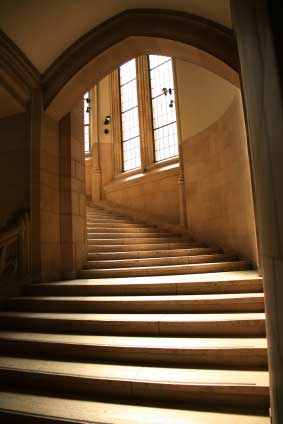Thinking Stair Design? Learn the Staircase Design Process Questions
When designing a staircase, interior designers have a great deal of scope to make a feature within the building. Learn the design process to make it run smoothly.
Stairs are more or less permanent and therefore need a great deal of consideration before they are designed and built.
They have physical safety considerations along with their aesthetic value. So here you will find some questions to ask yourself before putting pen to paper and design your master staircase! These questions and design process become second nature once you have designed several stairs, but it is always a good prompt for when you have a difficult stair case to design.
The questions you should pose when design concepting your staircase:
| Some of the things to consider are: Who is going to use the stair?
What is the stairs primary purpose (accessible, minor, secondary, etc)?’ Is it going to be a grand feature? What is the maximum and minimum width you have to work with within the building? How steep will it need to be? What will it look like? Theme, permanent materials, easy clean, industrial, indoor, outdoor? How many landings will it require to be a comfortable stair to climb? Can you use an open or closed riser ? The ideal height of the riser and the depth of the tread? And on and on it goes? |

Beautiful Stairwell, where are the handrails? |
The good thing is that most of the questions can be answered quickly by using your local building codes. They have strict rules as to the stair width, head height, tread width, riser height, and distance traveled before landings are required, balustrade spacings, handrail types and height.
So that is the first place to start, work out what type of stair you need in your building by law, i.e. accessible, minor or secondary. Then all the minimum and maximum measurements will be listed. You can then have a look at your space and start planning from there.
Once you have worked out the legal structural requirements, you can then concentrate on what it will look like.
Who uses a stair?
Who is going to use the stair? Everybody. No ……Yes………. is it predominantly a young or older family, are there elderly people using it regularly? While we are governed by rules and regulations on items such as this we should also use common sense when designing an important element such like a staircase. Don’t compromise on an important item such as a stair because it’s very difficult to change once it is built.
We need to know who is going to use the stair as one size does not fit all, and it will influence the tread finishes of the stair. Young Children and the elderly, disabled or physically impaired, these three groups have very definite needs and there are standards, which we adhere to. For example, for the visually impaired a contrasting stair nosing is an advantage as this means that they will be able to see the start of each tread easier. Often the contrasting stair nosing can also have a non slip surface which is ideal for the elderly and children who have two extremes, running up stairs and climbing them very slowly and tentatively.
Hand rails need to be continuous so that the climber has constant support, and an ample width is important for those who need a carer to help them climb the stair.
How much will a staircase cost?
Stairs are an intricate type of construction and they are not to be scrimped and saved on. You can purchase pre manufactured staircases in standard sizes to simply place into your stairwell, these are a cost effective but lacking in individual and personal style. There are cast concrete stairs which are often used in large apartment blocks, more expensive but you won’t get any creaks like a timber stair and they are very quiet to climb. The other way, which is what we have been describing here is to design your stair and a joiner will make it for you and deliver it to site where a builder will install it for you. It is usually made from timber or the cheaper option, MDF Board. This is more expensive than buying a ready made staircase, but you do get exactly what you want. We cannot place any exact prices on stairs fro you as this web site is international and they wouldn’t be relevant, but you could contact a staircase manufacturer direct for a ballpark figure of cost.
More Information about Stairs
